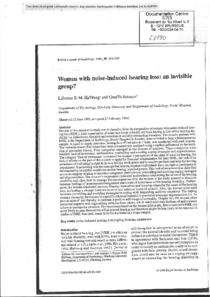Women with noise-induced hearing loss: an invisible group?

Hallberg, Lillemor R.-M. ; Jansson, Gunilla
1996
30
5
340-345
gender ; hearing loss ; notification of occupational diseases ; women
Occupational diseases
English
Bibliogr.
"The aim of this qualitative study was to describe, from the perspective of women with noise-induced hearing loss (NIHL), their experiences of noise as a threat to health and their having to live with a hearing disability, i.e. behaviours, thoughts and emotions in auditory demanding situations. Ten women, patients with NIHL at the Department of Audiology, Borás' Hospital in Sweden, were selected to form a heterogeneous sample. A taped in-depth interview, lasting from 45 minutes to 1 hour, was conducted with each woman. The verbatim transcribed interviews were consecutively analysed using a method influenced by the tradition of grounded theory. Four categories emerged in the process of analysis. These categories were labelled: lack of awareness, ambivalence, controlling and avoiding coping strategies and stigmatization. The category 'lack of awareness' concerned the women's perceptions of the risks of noise on hearing, the lack of efforts on the part of the women to apply for financial compensation for their NIHL, the lack of an awareness of individual's right to have healthy work-place and to receive professional help for hearing impairment. Also lacking was the concept that hearing impaired individuals have the right to participate in the community on similar conditions as non-hearing impaired people. This lack of awareness was identified as a core category relating to the other categories: ambivalence, controlling and avoiding coping strategies and stigmatization. The women's expressions indicated ambivalence concerning the cause of the hearing disability and, also, how to manage the consequences of it: the women in the study seemed to alternate between feelings of hopelessness/resignation and a state of acceptance of the hearing disability. Furthermore, the women alternated between blaming themselves and blaming others for the cause of the hearing loss, indicating a change between internal and external locus of control. Also, the women alternated between controlling and avoiding strategies in coping with demanding auditory situations. The coping strategy chosen by the women in a specific situation intended to prevent or minimize stigmatization, i.e. 'to pass as normal' and thereby to maintain a positive self-image of normality. Despite this, the women often perceived negative and stigmatizing attitudes from others, which reinforced their feelings of ambivalence in how to manage the situation. The hypothesis based on the present pilot study, that women with NIHL are more likely to pass themselves off as normal hearing and therefore might be less likely to be reported in studies of NIHL than men, needs to be further tested in a larger sample."
Digital
The ETUI is co-funded by the European Union. Views and opinions expressed are however those of the author(s) only and do not necessarily reflect those of the European Union or the ETUI.